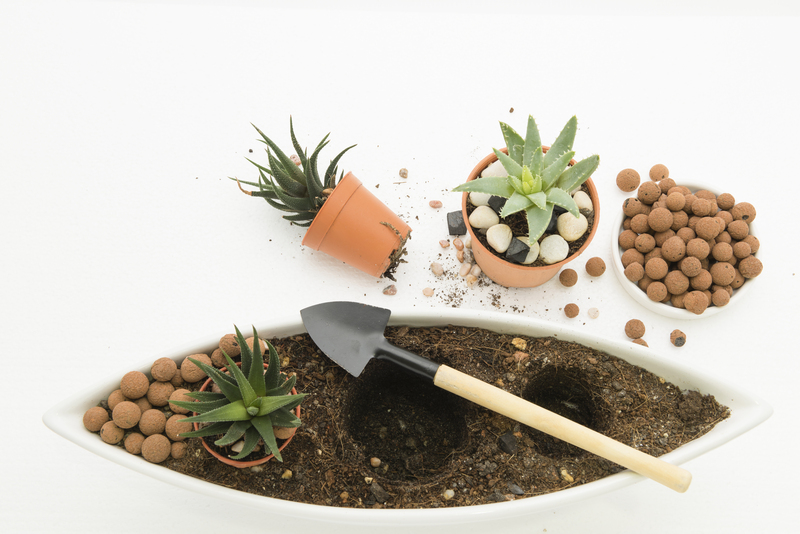Breathing Life into Your Neglected Garden
Posted on 29/09/2025
Breathing Life into Your Neglected Garden: A Comprehensive Guide
If your backyard has become an overgrown tangle, full of weeds and faded soil, it's time to consider breathing life back into your neglected garden. Reviving an abandoned outdoor space isn't just about improving property value--it can transform your home into a sanctuary and provide a daily connection to nature. In this in-depth article, we will guide you step-by-step through restoring vibrancy, color, and productivity to even the most forgotten garden plots.

Understanding Garden Neglect: The First Steps
Before jumping in with spades and pruners, it's essential to assess the situation. What causes garden neglect? Life is busy, weather is unpredictable, and sometimes, maintaining our outdoor spaces just gets pushed aside. Overgrown plants, pests, poor soil, and lack of structure are common signs your garden needs attention.
- Overgrown vegetation: Weeds and wild growth competing for nutrients
- Compacted or depleted soil: Lack of compost or organic matter leading to hard, dry ground
- Broken or neglected structures: Sagging fences, broken planters, or collapsed trellises
- Pest infestations: Snails, insects, rodents, or fungal issues thriving in untended environments
- Dead or unhealthy plants: Yellowed leaves, bare stems, or brittle branches
By identifying these trouble spots, you can make a targeted plan for revitalizing your garden.
Setting Clear Goals for Garden Revival
- What is your vision? Would you like a productive vegetable patch, a floral retreat, or a wildlife-friendly habitat?
- How much time and budget do you have? Be honest; revitalization takes effort, but small steps make a big impact.
- What resources and tools are at your disposal? Assess what you already own--gloves, pruners, compost bin, stakes, and more.
_Once you are clear about your aims, it's much easier to create an actionable and sustainable approach to breathing new life into your struggling garden._
Cleaning Up: Reclaiming Your Garden Space
Tackling Overgrowth and Debris
Begin by removing everything that's dead, dangerous, or beyond saving. Use shears and pruners to cut back overgrown shrubs, vines, and tree branches. Rake away fallen leaves, broken branches, and accumulated debris. For stubborn weeds, use a hoe or manual weeding tool, and dispose of roots thoroughly to prevent regrowth. If you're organically-minded, consider composting non-infected green material.
- Wear protective gear. Gloves, boots, and eye protection are essential for handling old brush and brambles.
- Sort as you go. Separate materials for compost, municipal green waste, or landfill.
- Don't be afraid to be ruthless. Unhealthy plants and invasive species will only hinder your garden's revival.
Assessing and Repairing Structures
During your cleanup, closely inspect garden beds, fences, pathways, and irrigation systems. Reinforce wobbly fences, repair trellises, or replace broken stepping stones. This not only sets a neat framework for plants but also motivates future maintenance.
- Fix garden beds and paths - define clear borders to keep weeds at bay
- Check water features - clean bird baths, fountains, and repair leaks
- Test irrigation systems - ensure hoses and sprinklers function properly
Soil Revival: The Foundation of a Healthy Garden
After a garden has been left unattended, soil structure and fertility often suffer. Compacted soil blocks roots and water, while years of neglect strip away vital nutrients. Restoring living soil is the heart of breathing new vitality into your outdoor space.
Testing and Amending Soil
- Test soil pH and fertility. Affordable home test kits will reveal if your soil is acidic, alkaline, or lacking in key minerals.
- Add compost and organic matter. Mix in well-rotted compost, leaf mold, or aged manure. This boosts soil microbes and nutrients.
- Loosen and aerate. Use a garden fork to break up hard earth, improving root penetration and water drainage.
- Mulch liberally. A 2-3 inch layer of mulch helps retain moisture and reduce future weed growth.
_Nurturing the soil is the cornerstone of any thriving garden restoration. By improving this foundation, you dramatically boost your chances of garden transformation success._
Strategic Planting: Choosing the Right Plants for a Revived Garden
Assess Your Site's Conditions
- Light: Track the sun patterns throughout the day.
- Drainage: Note soggy or drought-prone areas.
- Microclimates: Identify sheltered corners or exposed spots.
Select plants suited to your conditions. Hardy perennials, native species, and drought-tolerant varieties often establish quickly, crowd out weeds, and demand less maintenance--ideal for revitalizing a neglected garden.
Rebuilding Borders and Beds
- Group plants by needs - sun, water, and soil preferences
- Stagger heights and textures for a natural look
- Start with reliable backbone plants (shrubs, ornamental grasses)
- Fill in with seasonal color and pollinator-friendly flowers
- Leave space for growth and airflow
If instant impact is your goal, incorporate fast-growing annuals and groundcovers while slower plants mature. Layering is key--combine bulbs, perennials, and small trees for year-round interest.
Watering and Fertilizing: Giving Your Garden a Fresh Start
Setting Up a Smart Watering Routine
Neglected soil may be parched or waterlogged. Deeply water new plants in the early morning or evening. If possible, install a soaker hose or drip irrigation--the most effective way to keep roots consistently moist without waste or disease.
Feeding Your Plants
- Use slow-release fertilizers or organic feeds to avoid overwhelming stressed plants.
- Top-dress beds with compost every few months to build long-term fertility.
Combatting Pests and Weeds Humanely
Restoring a neglected garden can spark flare-ups from pests and weeds. Early intervention is critical.
- Pull weeds by hand, especially before they seed
- Encourage beneficial predators like ladybugs, frogs, and birds by providing habitat
- Use barriers such as mulch, row covers, or netting for vulnerable seedlings
- Inspect plants regularly for signs of stress or infestation
- Practice companion planting to naturally deter pests (like marigolds with vegetables)
If you must use chemical controls, opt for targeted, least-toxic options and apply only as a last resort. The goal is to foster a balanced, resilient ecosystem as you breathe new life into your once-forgotten space.
Adding Personality: Designs and Features for Your Reclaimed Garden
Incorporating Pathways and Seating
Restoring structure and flow is just as important as selecting plants. Define walking paths with gravel, stepping stones, or bark chips. Clear a space for a benched nook or hammock to enjoy your efforts.
Install Wildlife-Friendly Features
- Bird baths and feeders to attract songbirds
- Pollinator hotels and butterfly puddling areas
- Piles of logs, rocks, or brush for hedgehogs, toads, and beneficial insects
These small features will not only increase biodiversity but also boost your sense of connection and pride as your outdoor area springs back to life.
Play With Color and Art
Bold planters, painted fences, mosaic stepping stones, or recycled garden art add charm and individuality. As you maintain your rejuvenated garden, consider rotating container displays to keep things lively and seasonal.
Sustainable Maintenance Strategies for Garden Longevity
Reviving a neglected plot is only the beginning. For a living, thriving garden that endures, regular care--however brief--is essential.
- Inspect weekly for weeds, pests, and plant health
- Mulch annually to suppress weeds and conserve moisture
- Rotate crops and flowers to maintain soil fertility and break pest cycles
- Prune and deadhead plants to encourage vigorous growth
- Add compost to replenish your soil year after year
Remember, you don't need to tackle everything at once. A few minutes each week will help prevent another cycle of neglect and ensure your efforts yield lasting rewards.

From Abandonment to Abundance: Inspiring Garden Revival Success Stories
Across the world, thousands of gardeners have transformed forgotten spaces into flourishing sanctuaries. Whether it's a suburban backyard, an urban plot, or a balcony container garden, the process of breathing new life into a garden enriches families, neighborhoods, and communities.
- A cottage garden bursting with wildflowers and pollinators that was once a patch of nettles
- A productive veggie patch grown on the bones of a depleted lawn
- A wildlife haven supporting frogs, bees, and birds thanks to a simple pond and native plantings
Your neglected garden is full of untapped potential. With vision, patience, and a few weekends of dedicated effort, you can create an inviting retreat that brings you joy for years to come.
Start Breathing Life Into Your Garden Today
Revitalizing a neglected outdoor space might seem daunting, but every step brings you closer to a personal oasis. Start small, gather your tools, and tackle the cleanup, soil repair, planting, and design--one task at a time.
With care, commitment, and creativity, you can transform your neglected garden into a vibrant, flourishing retreat. Your home, family, and the local wildlife will thank you!

